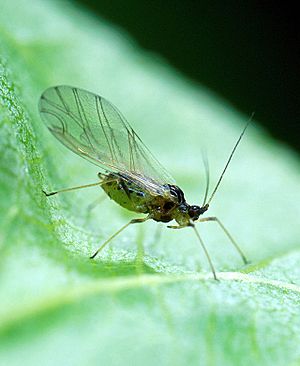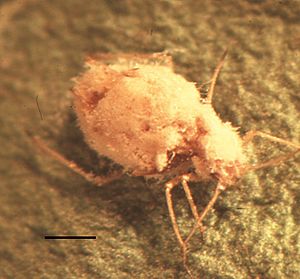Myzus persicae facts for kids
Quick facts for kids Myzus persicae |
|
|---|---|
 |
|
| Scientific classification | |
| Genus: |
Myzus
|
| Species: |
persicae
|
The green peach aphid (Myzus persicae) is a tiny green insect. It's also called the greenfly or peach-potato aphid. These insects are a type of aphid and belong to a group called Hemiptera. They are a big problem for peach trees. They can make trees grow less, cause leaves to shrivel, and even kill parts of the plant. Green peach aphids can also spread harmful plant viruses. These viruses include cucumber mosaic virus and potato virus Y. They can spread these diseases to many food crops, especially potatoes and other plants in the nightshade family. A Swiss scientist named Johann Heinrich Sulzer first described this aphid in 1776. Its scientific name, persicae, means "of the peach" in Latin.
Contents
Life cycle
The life cycle of the green peach aphid changes a lot. It mostly depends on how cold the winter is. A new generation of aphids can grow in just 10 to 12 days. More than 10 generations can appear in one year. In warm places, there can be as many as 30 to 40 generations.
In early spring, eggs that survived the winter hatch. The young aphids, called nymphs, start to feed. They eat buds, flowers, young leaves, and stems. The worst damage happens in early summer. This is when many aphids are breeding. Winged aphids fly from Prunus trees (like peach trees) where their eggs were laid. They then land on summer plants like tobacco, potatoes, and cruciferous vegetables. They keep causing harm for many generations.
Distribution
The green peach aphid is found all over the world. However, it does not do well in very cold places. It spends the winter as an egg, laid in trees of the Prunus group. These aphids can also live well in greenhouses in colder areas.
Description
Adult green peach aphids appear in the summer. They are about 1.8 to 2.1 millimeters long. Their head and chest are black. Their body is yellow-green with a dark spot on the back. Young aphids (nymphs) are first greenish, then yellowish. Those that will become winged females might look pinkish. Adult aphids without wings look like nymphs. They are about 1.7 to 2.0 millimeters long.
Green peach aphids can be yellowish-green, red, or brown. Their color can change based on the plants they eat. It also depends on how much food they get and the temperature.
In warmer months, and all year in warm places, green peach aphids reproduce without mating. Adult aphids produce nymphs on many different soft plants. These include many vegetables like cabbage and its relatives (Brassica). They also feed on potatoes and other plants in the Solanaceae family. Other host plants include celery, mustard, pepper, pumpkin, okra, corn, and sunflowers. Weeds like white goosefoot (Chenopodium album) also host them. An aphid can start having babies just 12 days after it is born. In warm areas, up to 20 generations can happen in a year. When the weather gets cooler, aphids mate. They lay tiny oval eggs (0.6 mm by 0.3 mm) in cracks in the bark of Prunus trees.
The green peach aphid is a farm pest across the United States and worldwide. This includes Australia. Farmers use sprays to control them, but the aphids can become resistant. Many of their natural enemies can help control them. For example, ladybirds can be used in radish fields. The tiny wasp Diaeretiella rapae helps control them in broccoli.
Protecting and using natural enemies can help control the number of green peach aphids. These enemies include:
- Lady beetles (like the two-spotted ladybird and seven-spotted ladybird)
- Flower flies
- Lacewings (like green lacewings)
- Parasitic wasps (like Aphidiinae)
- Hoverflies
- Gall midges (like Aphidoletes aphidimyza)
Aphids can also be killed by certain fungi.
Pest impact
A lot of green peach aphids can harm the quality of crops. If there are too many, plants can suffer from lack of water. They might wilt and grow slower. A long-lasting aphid problem can greatly reduce the amount of root crops and leafy crops a farmer can harvest.
The green peach aphid spreads several harmful viruses in pepper plants. These include pepper potyviruses and cucumber mosaic viruses. These viruses make plants turn yellow. They also cause leaves to curl downwards and inwards from the edges.
The green peach aphid can harm over 400 types of plants. These plants belong to more than 50 different families. By sucking plant sap, the aphids take away nutrients from crops. This stops the plants from growing well. The aphids also leave behind sticky droppings called honeydew. This honeydew builds up on leaves. It can cause mold to grow, which affects plant growth and quality. The aphid is also a main carrier of plant viruses. It is known to spread 78 different plant viruses.
Control methods
Physical and mechanical control
One helpful way to control green peach aphids is to use their dislike for shiny surfaces. Farmers can hang silver-grey film or use silver-grey nets over fields. This stops the aphids from landing and settling on plants. Adult aphids can also be caught using traps. These traps use sweet or sour liquids that aphids like. For example, a mix of water, vinegar, and brown sugar can trap and kill them.
Farming practices
Farmers often fight green peach aphids using good farming methods. Changing how plants are arranged in the field can help. Adjusting when seeds are planted and when crops are harvested also helps. Deep plowing and turning over soil in winter can reduce aphid numbers. Using the right amount of plant food and watering plants at the right time also helps reduce damage.
Biological control
Using natural substances from plants is becoming more important. This is because people care more about protecting the environment. These plant substances can help control aphid numbers.
Insect growth regulators like diflubenzuron and chlorbenzuron can be used. Also, natural plant-based pesticides like nicotine and azadirachtin help manage pests in orchards. They reduce the number of green peach aphids and the harm they cause. Farmers can also use artificial insect pheromones. These are special scents that attract natural enemies of the aphids. For example, E-β-farnesene (EβF) is an aphid alarm pheromone. It can confuse aphids and stop them from finding food. It also attracts many of the aphids' natural enemies. This helps control the aphid population.
Chemical control
Some common chemical sprays used to control aphids include cypermethrin, abamectin, chlorpyrifos, methylamine, and imidacloprid. While imidacloprid is good for controlling pests that suck plant sap, using it too often can make the aphids resistant to it.
Images for kids
See also
 In Spanish: Pulgón del melocotonero para niños
In Spanish: Pulgón del melocotonero para niños



